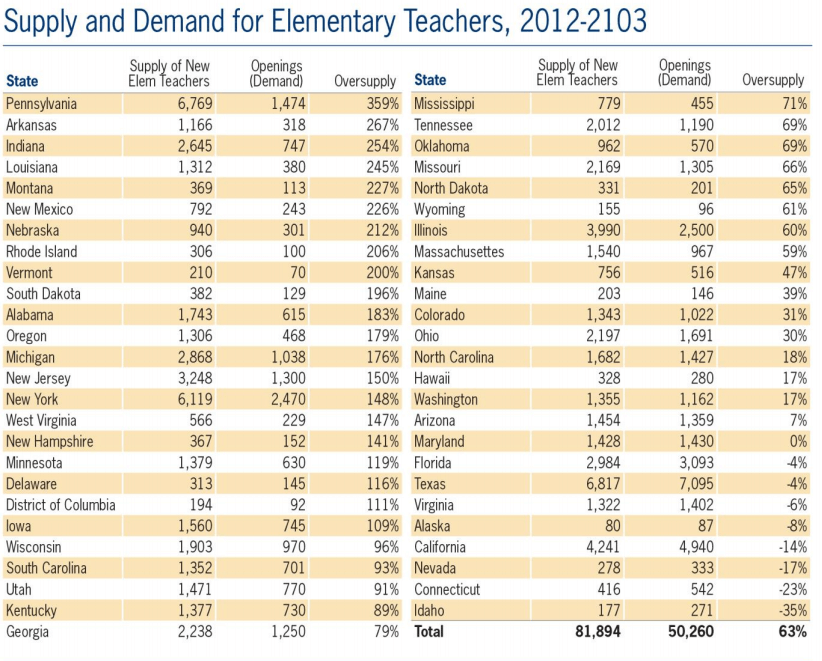This is the best time of year to discuss the issue of teacher shortages. Emotion is removed from the equation because classrooms have been staffed and the school year is rapidly reaching the half-way mark. Without the pressure of a looming new school year, a more rational analysis of the issue can be offered.
The media has painted a panic-driven picture of a system-wide teacher shortage in the U.S., including here in Kansas, one they say will only get worse. And it has reached almost truism status in the education community. People like Linda Darling-Hammond of the Learning Policy Institute want us to believe that a teacher shortage is a nationwide problem that needs immediate attention.
However, a closer look at teacher shortages reveals that it is a much more nuanced problem. In an Education Week webinar, Kate Walsh, the president of the National Council on Teacher Quality, presented “A Critical Examination of Teacher Shortages.” According to Walsh, the problem is not a nationwide one, but a state and local issue, and rooted in local labor markets. She faults the education community for not recognizing that the profession of teaching is not immune to those forces. As she points out and other research supports, the preponderance of teacher shortages occur in the STEM and special education fields. Walsh provides compelling evidence that there continues to be a glut in the supply of elementary and non-STEM secondary teachers – what she calls “a chronic overproduction of teachers.” This NCTQ table shows that nearly every state supplies more elementary teachers than there are openings. Note that Kansas had a 47% oversupply, according to the latest available data.
 Her solution is one of basic economic supply and demand that can be addressed at three levels:
Her solution is one of basic economic supply and demand that can be addressed at three levels:
- Teacher prep programs should be reducing the number of students who are pursuing elementary teaching degrees and steer them to those fields in higher demand. Of course it is an individual’s right to pursue whatever degree one wants, but teacher prep programs should be providing their students better information regarding job market realities. Unfortunately, the programs have no incentive to do so.
- Differentiated pay for teachers in high demand/short supply fields is an absolute.
- School districts should use their control over student teaching placements. Schools should not be accepting student teachers in areas where there is an oversupply. If schools begin to accept only student teachers where there is need like STEM, SPED and ELL, perhaps teacher prep programs will work closer with students to encourage them to enter those disciplines.
Walsh’s solutions are a welcome counterpoint to Darling-Hammond’s answers, who wants to frame the problem as universal and believes the solutions should be likewise and not necessarily even limited to the supply of teachers. Darling-Hammond uses her version of a shortage to call for higher teacher salaries across the board and other financial incentives like housing, child care and loan forgiveness. She doesn’t seem to understand that universal solutions will lead to an even bigger imbalance in teacher supply because it doesn’t address the problem directly, it’s akin to using a sledgehammer to push a pin.
The attention to this issue serves as a reminder of just how important the role of the teacher is in a child’s education. It’s part of what makes teaching a profession. I know because it was mine for two decades. But as is true in any profession, we must recognize that market forces play a role. And as we are now experiencing, avoiding that reality can impact student learning.
That being said, what does this mean for Kansas? Although any teaching vacancy due to a lack of supply is a problem, we generally compare favorably to other states, although you might not know it from what the media reports. And in this previous blog, I reacted to a blue ribbon committee that was formed to look at teacher shortages in Kansas. Like Linda Darling-Hammond, they attempted to make a narrow regional issue into a statewide problem, with likewise solutions. If we are to stay ahead of the curve and avoid real significant teacher shortages, it would be best to look at it through the NCTQ prism as a labor market issue and follow their market-based solutions. That’s what would be best for Kansas students.




